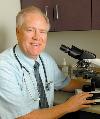 Click to Print Adobe PDF
Click to Print Adobe PDF
Fall 2009 - Vol.4, No.3
Infertility, Economics, and Common Sense
Paul E. Visneski, D.O.
May-Grant Associates.
|
 |
BACKGROUND
Infertility, a disease affecting 2 million couples in the United States, is defined as failure to achieve pregnancy after a year or more of regular unprotected intercourse. Last year, the Practice Committee of the American Society of Reproductive Medicine (ASRM) recommended that women over age 35 receive expedited evaluation and treatment for infertility if they have not conceived after 6 months, or earlier if clinically indicated.
Evaluation of infertility includes the following procedures: complete history and physical examination, complete semen analysis,[1] evaluation of uterine and tubal patency,[2] sperm and cervical mucus interaction,[3] ovulation testing,[4] ovarian reserve testing,[5] and evaluation of peritoneal abnormalities.[6] This evaluation should be completed in a timely manner and over the course of two cycles at most. For about 90% of cases, a problem will be identified and should be corrected. The remaining 10% will have "unexplained infertility."
Age and Demographics
In reality, as practitioners we should be addressing the topics of fertility and family planning with our patients well before they reach age 35. Overall, the probability that a single cycle will result in pregnancy (cycle fecundability) is about 25%. Fecundability peaks when a woman is in her mid-20s, decreases slightly to around age 32, declines progressively after age 35, and declines rapidly after age 40. According to the National Survey for Family Growth in 2002, approximately 12% of women had impaired fecundability. Women who are past age 35 are less likely to get pregnant than are younger women. Also, infertility treatment may not be successful in older women. Even with correction of a woman's specific problems, it will take an older woman longer to conceive. Moreover, miscarriages occur in about 20% of pregnancies, and each pregnancy takes 9 months to complete. Thus, it will take longer for an older woman to complete her family than she may realize. Why wait to initiate a discussion on family planning until age 35 when the woman is already at risk for other pregnancy-related complications?
Economics
When it comes to reproduction, the capital resources are oocytes. Economics is the study of how people use their limited resources, their oocytes, to achieve their goal - pregnancy. Economically speaking, we should be encouraging couples to complete their childbearing by age 35 to maximize the outcome of their fertility and to decrease their risk of hypertension, gestational diabetes, cesarean section, aneuploidy, and miscarriage. All these problems increase with advanced maternal age. The current recommendation suggests that we expedite the workup and evaluation of those patients aged 35 and older, maximize the therapies that are known to be effective, and if we are unsuccessful make the transition to assisted reproductive technologies prior to depletion of the ovarian reserve.
But economic analyses also must consider the patients' ability to pay the costs of reaching their goal, and some of these costs can be considerable. With regard to in vitro fertilization, it is not a technology that can be turned off. In the case of Nadya Suleman, and other women who have become famous (or notorious) after having multiple births, implanting multiple embryos can result in drastic consequences medically, financially, emotionally, and physically for both mother and children.
What Should the Doctor Do?
There are important steps to be initiated by the primary care providers long before the consultation for infertility evaluation. They should address all modifiable lifestyle issues to all women of reproductive age—15 to 44 years old. For example, obesity and weight loss management must be discussed and treated long before age 35. Weight loss will take time to accomplish through diet and exercise alone and may require bariatric surgery, if necessary. Remind patients of the increased risk of insulin resistance, hypertension, diabetes, uterine cancer, breast cancer, wound infection, and deep vein thrombosis for obese patients. In fact, weight loss will improve ovulation in most patients and probably decrease the likelihood of needing further infertility evaluation.
Providers should also stress the importance of quitting smoking to decrease the risk of intrauterine growth restriction of the baby if they become pregnant and ultimately decrease the risk of all female cancers and chronic pulmonary disease. Stress management and avoiding excess alcohol and caffeine should be recommended. All patients should take a multivitamin with at least 400 mcg of folic acid to prevent neural tube defects. Patients should also take at least 1000 mg of calcium each day.
Counseling individuals to at least consider completing their childbearing by age 35 is a crucial step in providing comprehensive reproductive healthcare for patients and for helping patients complete their families.
References
[1] Complete semen analysis should include volume, concentration, motility, morphology (shape), and inspection for WBCs or other cells.
[2] Evaluation of uterine and tubal patency involves a hysterosalpingogram, with injection of contrast through the uterus and tubes.
[3] Sperm and cervical mucus interaction is a post-coital test. Though still performed by some physicians, the American Society of Reproductive Medicine does not recommend its routine use because "it has not been shown to be of value in increasing pregnancy rates."
[4] Ovulation testing is done through urinary LH (luteinizing hormone) monitoring, ultrasound monitoring of follicular development, and serum hormone assays.
[5] Ovarian reserve testing, usually done in older women, assesses the adequacy of the remaining oocytes. The most common tests are: cycle day-3 FSH (follicle stimulating hormone) and estradiol. Also used is a clomiphene citrate challenge test (day-3 FSH and estradiol, clomiphene days 5-9, and FSH again on day 10).
[6] Evaluation of peritoneal abnormalities involves laparoscopy to evaluate for endometriosis, adhesions, etc.
Paul E. Visneski, D.O.
May-Grant Associates
694 Good Drive – Suite 112
Lancaster, PA 17601
717-397-8177
pevisnes@LGHealth.org